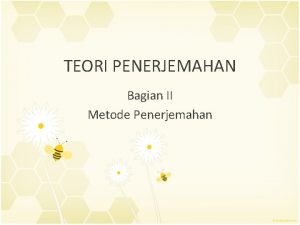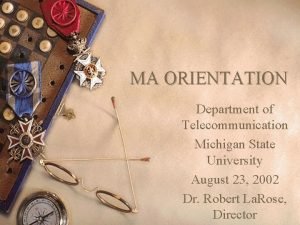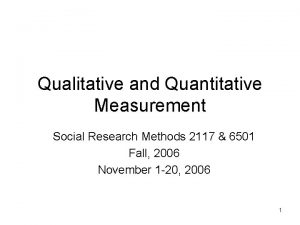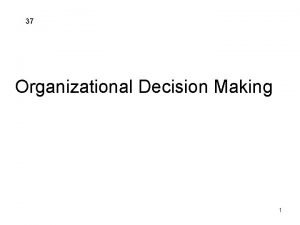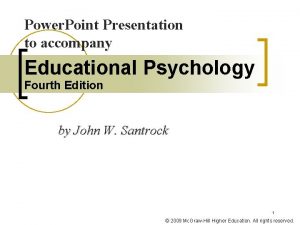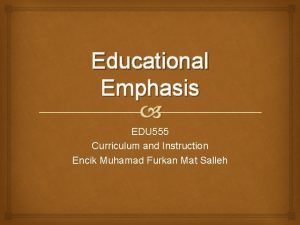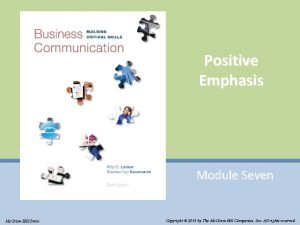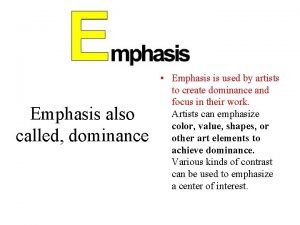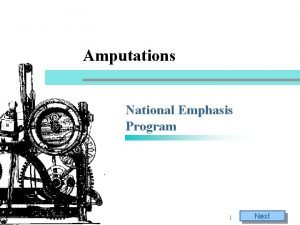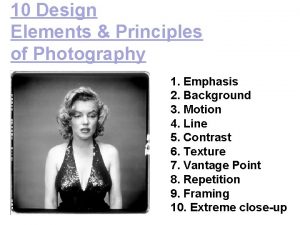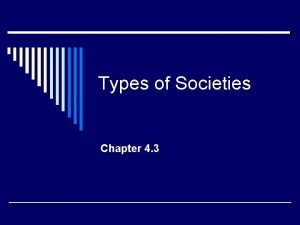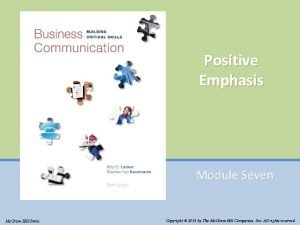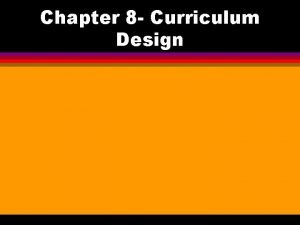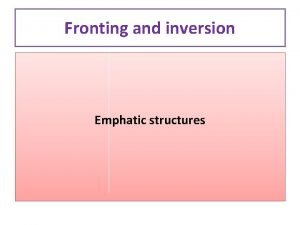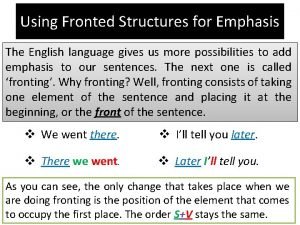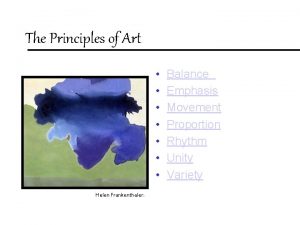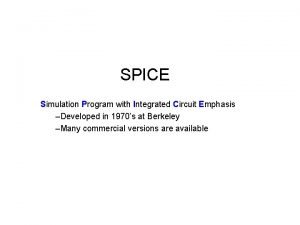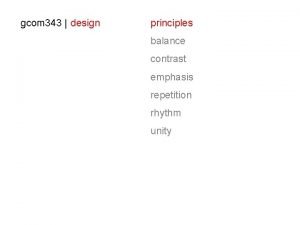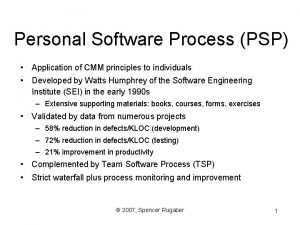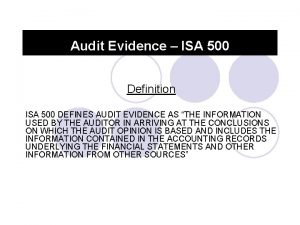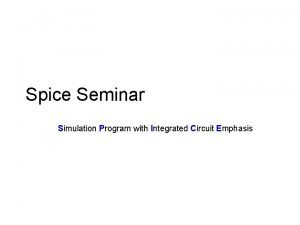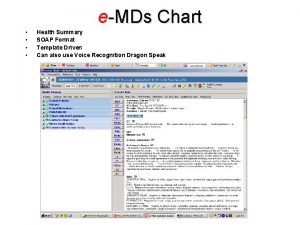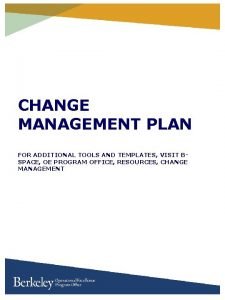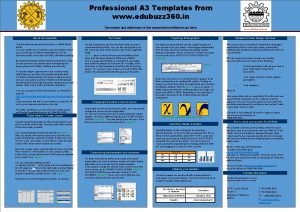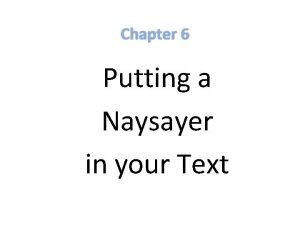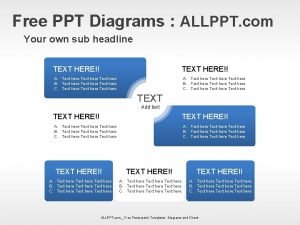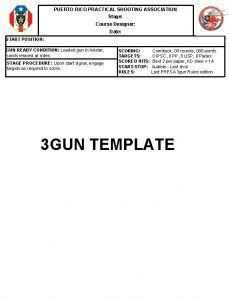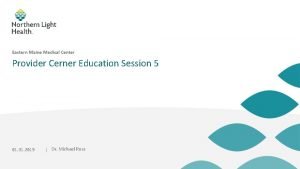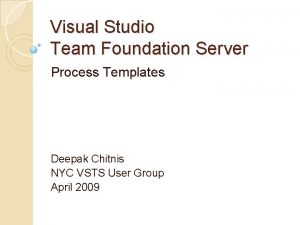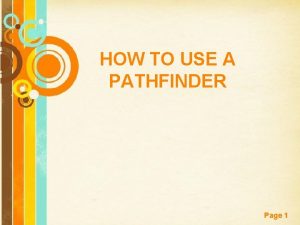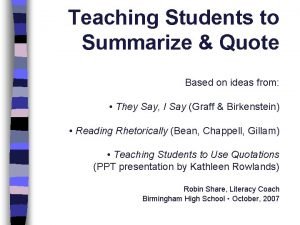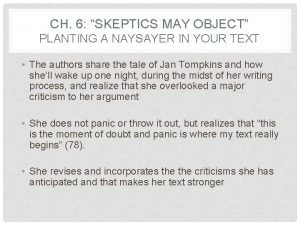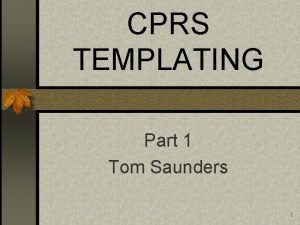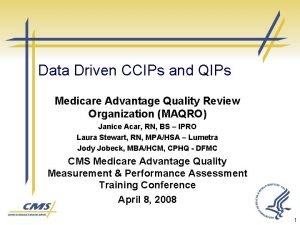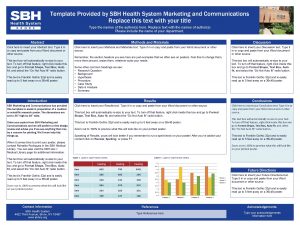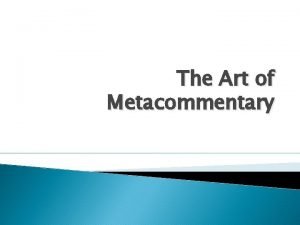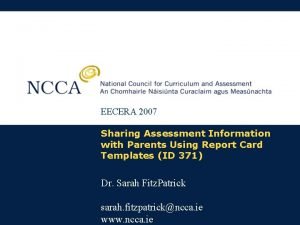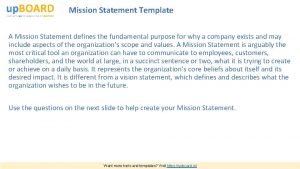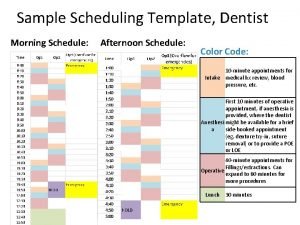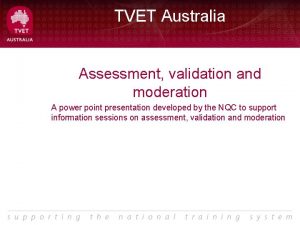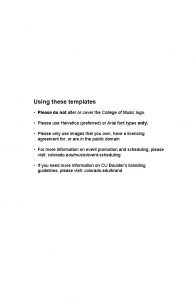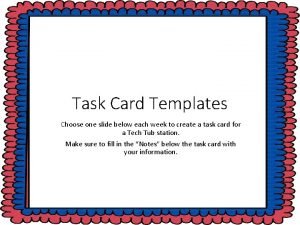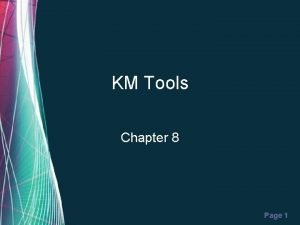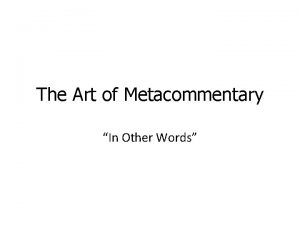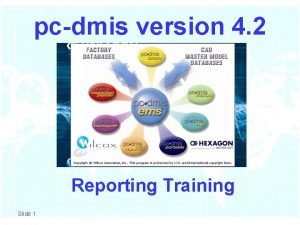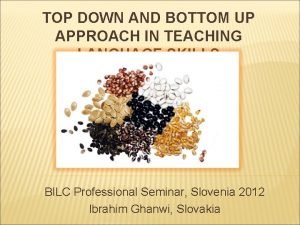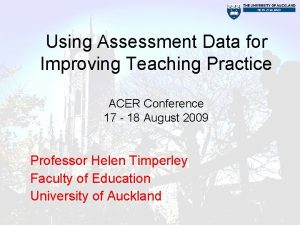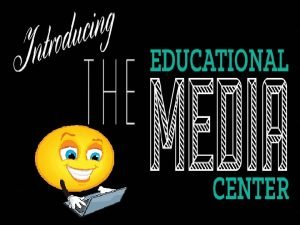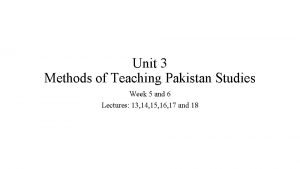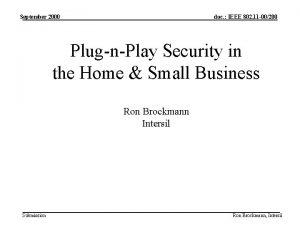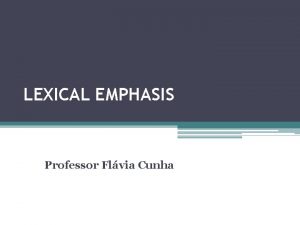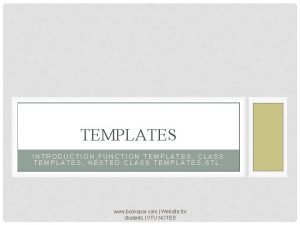Teaching Templates PlugnPlay Templates with an emphasis on





![“What we’re asking is for the missionary to prepare an outline [lesson plan] during “What we’re asking is for the missionary to prepare an outline [lesson plan] during](https://slidetodoc.com/presentation_image_h/14b97713fbd35a0d75d46220927a78e2/image-6.jpg)




























































































![[Insert block to be studied] You will have 10 -15 minutes to read through [Insert block to be studied] You will have 10 -15 minutes to read through](https://slidetodoc.com/presentation_image_h/14b97713fbd35a0d75d46220927a78e2/image-99.jpg)


















































- Slides: 149

Teaching Templates Plug-n-Play Templates with an emphasis on the Teaching Pattern

1: Small Group (Introduction) Teaching Templates for The Basic Pattern Outcomes

Principles and Doctrines Practice: 1. Think of a favorite scripture or scripture story. 2. Share the context 3. Identify the doctrine (gospel truth). • Usually one or two words (‘faith’, ‘obedience’, etc) 4. Show understanding of a principle (moral of the story). • Usually a sentence that uses “we” or “if…then” 5. Feel the importance by sharing a personal application • Typically uses “I statement (“If I…” or “I will…” or “I just know that if I…”)

1. 2. 3. 4. 5. 6. Insert scripture passage Insert scripture passage • Share the context (storyline). • Identify a doctrine (gospel truth). • Understand (share) a principle (moral of the story). • Feel the importance by sharing a personal Application (“I once…” or “If I…” or “I will…”)

2: Teaching Outline Teaching Templates for The Basic Pattern Outcomes
![What were asking is for the missionary to prepare an outline lesson plan during “What we’re asking is for the missionary to prepare an outline [lesson plan] during](https://slidetodoc.com/presentation_image_h/14b97713fbd35a0d75d46220927a78e2/image-6.jpg)
“What we’re asking is for the missionary to prepare an outline [lesson plan] during personal and companion study, personalized for who will be taught that day” (in “Be One of the Greatest, ” New Era, Mar. 2004, 14). “Missionaries prepare outlines to plan how they are going to teach an investigator according to his or her needs. The outline [lesson plan] helps the missionaries conceive the presentation in their own minds. If the presentation is well conceived, it is clear, and then the words will come easily as missionaries teach by the Spirit” (Elder Charles Didier, “Teaching from the Heart, ” Ensign, June 2004, 8).

Teaching Template Prepare a Missionary Teaching Outline • • Scripture: ______________ Context: ______________________________ Identify: One doctrine (great phrase) in your verses. Understand & Feel: Think of an example. How have you seen the power of this doctrine in your own life? Apply: What do you think God wants us to do because of this principle? 1. 2. 3. 4. 5. 6. 7. Insert Passage Insert Passage

3: Around the Room Teaching Templates for The Basic Pattern Outcomes

“The wise use of writing exercises and small group work can help teachers enhance the conditions of learner readiness and participation and “be an effective way to have the Holy Spirit help students make personal application of gospel principles” (Teaching the Gospel: A Handbook for CES Teachers and Leaders [1994], 41).

Around the Room • Working in pairs, you will have 90 seconds per verse (station) to discover a principle/lesson/truth • Write a statement of truth, based on the block, in your study journal. • After, you will see questions/scenarios that you will respond to using your notes. • Example: 1 Nephi 16: 2 -3 — “The guilty taketh the truth to be hard” • Principle: When something true, I should examine my life and seek repentance, rather than being a rebel.

Teaching Template: Around the Room 1. 2. 3. 4. 5. 6. 7. 8. 9. 10. 11. 12. Insert scripture passage Insert scripture passage Insert scripture passage

Let’s begin

Rotate Write down a principle/lesson/truth In your journal. After, you will see questions/scenarios that you will respond to using your notes.

Rotate Write down a principle/lesson/truth In your journal. After, you will see questions/scenarios that you will respond to using your notes. Copy and Paste this slide for as many rotations as you have around the room

You’re done!

• Take out your cell phone • Please respond (appropriately) to this question: What is something you are struggling with right now in life? (hardships, questions, problems, etc) • http: //www. polleverywhere. com/ • Please respond to the questions, concerns, problems, etc of your peers using the principles you have found in today’s study.

4: Group Rotations Teaching Templates for The Basic Pattern Outcomes

“Small group activities can often allow a greater number of students to participate and can provide a safe environment where students can share feelings, thoughts, and testimony with each other. These activities can also provide opportunities for students to teach the gospel to others and help prepare them to teach the gospel in the future. Discussions in small groups can enable students to develop communication skills and strengthen appropriate social and spiritual relationships. ” (Teaching the Gospel: A Handbook for CES Teachers and Leaders).

Rotation Below are a few blocks of scripture. Every few minutes, you will rotate to a new group of people to discuss the content of the next block. 1. 2. 3. 4. 5. 6. Insert scripture passage Insert scripture passage Context: What is the background of this story? Identify: Find one or two doctrines in this verse. Understand: Are there any challenging words in the verse that need clarification? What’s the moral or application of the story? What have the prophets taught about this doctrine? Feel: How have you seen the power of this principle your life? Is there a hymn or primary song that can help? A Mormon Message? An object lesson that would demonstrate application? Apply: What do you think God wants us to do because of this principle? What goal could a person make to better live this principle?

5: Learn and Teaching Templates for The Basic Pattern Outcomes

Elder David A. Bednar “Learning by faith requires spiritual, mental, and physical exertion and not just passive reception. ”

Learn it and Teach it Identify principles from your passage and then teach it to a small group of your peers. In return, you will hear each member of your group teach their passage to you as well. 1. 2. 3. 4. 5. 6. Insert scripture passage Insert scripture passage Context: What is the storyline of this chapter? Identify: One doctrine (phrase) in your verses. Understand: Think of an analogy or object lesson that helps teach the doctrine/principle. Feel: How have you seen the power of this doctrine/principle in your life? Apply: What do you think God wants us to do because of this principle?

Group 1 Group 2 Group 4 Group 3 Group 5

2 1 5 4 4 2 1 3 3 5 4 2 1 1 3 5 2 3 5 4 2 1 3 5 4

1 1 Group 1 1 3 3 2 Group 2 2 2 4 4 Group 3 3 2 1 3 2 Group 4 4 5 5 Group 5 5

6: Drawing Teaching Templates for The Basic Pattern Outcomes

“It is often difficult to teach the intangible aspects of the gospel. The Savior often referred to earthly objects (like bread, water, candles, and bushels) to help His listeners understand spiritual principles. “Pictures can be used to help students visualize what the people, places, events, objects, and symbols in the scriptures looked like. ” (Teaching the Gospel: A Handbook for CES Teachers and Leaders).

Drawing Draw a picture of your story and then point out principles from your drawing. In return, you will see pictures and see applications from each member of your group. 1. 2. 3. 4. 5. 6. Insert scripture passage Insert scripture passage Context: What is the background of this story? Identify: Find one or two doctrines in this verse. Understand: Are there any challenging words in the verse that need clarification? What’s the moral or application of the story? What have the prophets taught about this doctrine? Feel: How have you seen the power of this principle your life? Is there a hymn or primary song that can help? A Mormon Message? An object lesson that would demonstrate application? Apply: What do you think God wants us to do because of this principle? What goal could a person make to better live this principle?

7: Finding Yourself Teaching Templates for The Basic Pattern Outcomes

“Writing down what we learn, think, and feel as we study the scriptures is another form of pondering and a powerful invitation to the Holy Ghost for continuing instruction” (Elder Bednar, “Because We Have Them before Our Eyes, New Era, Apr. 2006, 6– 7).

Finding Yourself in the Scriptures 1. 2. 3. Insert scripture passage Element/Symbol • • • Identify the. . . Context People Things Actions taken Consequences of Actions Feelings experienced Interpretation Figure out. . . 4. 5. 6. Insert scripture passage So What? Personal Experience Ask. . . Consider. . . The interpretations of the What connections do When was a time in elements/ I see? my life that I saw the Symbols What is the moral of “so what” happen? 1. How the story? elements are like What PRINCIPLE How could this general principles could I use from this principle affect future and practices. story to help me in decisions? 2. How the my life NOW? elements are like ME and God. What/Who do I think this story is really about?

8: Jesus Satan You Teaching Templates for The Basic Pattern Outcomes

“Symbols help with this spiritual communication. Through symbols, the Lord forges a link with us by using the things of this earth to represent the things of heaven. He has given us revelations, prophecies, teachings, ordinances, and ceremonies filled with symbols that can give us spiritual insights if we are prepared to receive them. ” (February 2007 New Era)

Jesus Satan You will be assigned one passage; look for symbols or principles of Jesus and Satan and then ask yourself how the principles you’ve written apply you. 1. 2. 3. 4. 5. 6. Insert scripture passage Insert scripture passage Jesus Satan You What symbols and principles of the Savior are in this passage? What symbols or principles of Satan are in this passage? What application or conclusion can be drawn for myself based on the symbols of Jesus and Satan in the passage?

9: Speed Dating Teaching Templates for The Basic Pattern Outcomes

“You can help one another stay strong and make good decisions. Getting together as friends can be a great setting. Some youth feel comfortable talking and socializing with members of the opposite sex. But others feel very nervous and awkward. This is not unusual. Those who are less comfortable can learn from those who are more comfortable. ” (Brad Wilcox, New Era, Aug. 2001)

Speed Dating You will meet 12 new people today; as you meet your new friend, share one thing about yourself with them, work through the teaching questions, and then ask them a random question 1. 2. 3. 4. 5. 6. Insert scripture passage Insert scripture passage 7. 8. 9. 10. 11. 12. Insert scripture passage Insert scripture passage Context: What is the background of this story? Identify: Find one doctrines in this verse. Understand: What’s the moral or application of the story? Feel: How have you seen the power of this principle your life? Apply: What do you think God wants us to do because of this principle? What are your post High. School plans? Choose a second language? Underwater or outer space? Favorite shoe brand? Favorite commandment? Favorite soup? If you could choose your mission, where would it be? Favorite bread? Favorite apostle? Favorite primary song? Favorite Temple? Why did your parents name your name? Favorite Animal? Favorite actor or actress? What is your favorite vacation? Who is your celebrity crush? Favorite thing to do in the summer? Favorite hymn?

10: Social Media Teaching Templates for The Basic Pattern Outcomes

“Occasionally, inviting students to respond to a thought-provoking question in writing helps deepen and clarify their thinking. Inviting students to respond to a question in writing before sharing their thoughts with the class gives them time to formulate their ideas and receive impressions from the Holy Ghost. Students may be more inclined to share their thoughts when they have written them first, and what they share will often be more meaningful. ” (Teaching the Gospel: A Handbook for CES Teachers and Leaders).

Social Media You will study a few passages of scripture today; for each one, you will need to choose to a Hashtag, Status Update, Tweet or Instagram Caption to demonstrate a truth from the passage. 1. 2. 3. Insert scripture passage 4. 5. 6. Insert scripture passage After reading your passage, create one of the following: Create a tweet that summarizes a principle based on the passage What would a Facebook status update sound like if a person were to post about a truth found in this passage Create a caption for an Instagram image of the passage What hashtag would summarize this passage?

11: Mormon Ads Teaching Templates for The Basic Pattern Outcomes

“It is often difficult to teach the intangible aspects of the gospel. The Savior often referred to earthly objects (like bread, water, candles, and bushels) to help His listeners understand spiritual principles. “Pictures can be used to help students visualize what the people, places, events, objects, and symbols in the scriptures looked like. ” (Teaching the Gospel: A Handbook for CES Teachers and Leaders).

Mormon Ads Create a Mormon Ad based on principles from your assigned block of scripture 1. 2. 3. 4. 5. 6. Insert scripture passage Insert scripture passage Create a Mormon Ad – Read the verse together and identify a principle or application – Create a catchy phrase or title for your Ad – Draw a picture that illustrates the principle of the verse (include the scripture reference and part of the verse on your drawing) Context: What is the background of this story? Identify: Find one or two doctrines in this verse. Understand: What have the prophets taught about this doctrine? Feel: How have you seen the power of this principle your life? Apply: What do you think God wants us to do because of this principle?

12: Line upon Line Teaching Templates for The Basic Pattern Outcomes

“The Lord’s pattern and process for giving us spiritual knowledge is found in the phrase “line upon line, precept upon precept” and describes a central feature of the Lord’s pattern. ” (Elder Bednar, September 2010 Ensign)


Line Upon Line Use quotes, the Bible Dictionary, Conference Talks, etc to bring a scripture passage to life by creating a “Line Upon Line” message. . 1. 2. 3. 4. 5. 6. Insert scripture passage Insert scripture passage Context: What is the background of this story? Identify: Find one or two doctrines in this verse. Understand: What have the prophets taught about this doctrine? Feel: How have you seen the power of this principle your life? Apply: What do you think God wants us to do because of this principle?

13: Something new in the Scriptures Teaching Templates for The Basic Pattern Outcomes

Something New?

What was the first item sold on e. Bay?

Something unique about all tongues?

Walt Disney had one fear….

Coke vs Diet Coke

Gangum Style

Alexander the Great

How many ants are in the world?

How many Americans are homeless?

What would happen if you ate a Polar Bear?

SOMETHING NEW IN THE SCRIPTURES 1. 2. 3. 4. 5. 6. Insert scripture passage Insert scripture passage Search your assigned block of scripture. Share something that others may not have known about… • The Context • A Doctrine or Principle Or • An Application Found within your scripture passage.

14: mormon. org chat Teaching Templates for The Basic Pattern Outcomes

What can I do to prepare most effectively to serve as a full time missionary?

What can I do to prepare most effectively to serve as a full time missionary? One of the questions I am asked most frequently by young men is this: “What can I do to prepare most effectively to serve as a fulltime missionary? ” The single most important thing you can do to prepare for a call to serve is to become a missionary long before you go on a mission. In our customary Church vocabulary, we often speak of going to church, going to the temple, and going on a mission. Let me be so bold as to suggest that our rather routine emphasis on going misses the mark. My earnest hope for each of young men is that you will not simply go on a mission—but that you will become missionaries long before you submit your mission papers, long before you receive a call to serve, long before you are set apart by your stake president, and long before you enter the MTC. http: //www. youtube. com/watch? v=Z 0 xg-U_TAp. I (Elder Bednar Becoming a Misionary)

Scan your assigned passage and identify missionary teaching topics and doctrines 1. 2. 3. 4. 5. 6. Insert scripture passage Insert scripture passage Visit the URL below and ask the volunteers at Mormon. org to help answer a question based on the doctrines you’ve identified in your passage. • http: //www. mormon. org/chat

15: Quiz Teaching Templates for The Basic Pattern Outcomes

Round 1 Scan your assigned passage and create a matching quiz based on principles in your block. 1. 2. 3. 4. 5. 6. Insert scripture passage Insert scripture passage EXAMPLE A. 12: 2 B. 12: 4 C. 12: 6 D. 12: 11 E. 12: 26 F. 12: 27 G. 12: 28 H. 12: 34 Read the verses to the left and select which principles best goes with that verse. 1. ____ If we recognize our weaknesses and are humble before God, then God will make us weak people strong. , 2. ____ People who mock others will eventually mourn. 3. ____ Without charity, we can not go to the Celestial Kingdom. 4. ____ The life of Christ shows us the more excellent way of living. 5. ____ Faith, hope and charity are the start of all righteousness. 6. ____ Having God’s Spirit with you makes you unstoppable. 7. ____ If we want a witness (manifestation) from God, then we have to try to be faithful first. 8. ____ Hope makes you steady in producing many good works.

Round 2 Complete another group’s quiz. Then select your FAVORITE principle and circle it.

Round 3 You will receive another group’s paper with a highlighted favorite principle. Find something to help us feel the importance of that principle and invite us to make an application based on it. Feel: How have you seen the power of this principle your life? What personal or scriptural example demonstrates this principle? Is there a hymn or primary song that can help? A cross reference? An object lesson? Apply: What do you think God wants us to do because of this principle? What goal could a person make to better live this principle?

16: Dinner Table Teaching Templates for The Basic Pattern Outcomes

A role play of a family at the dinner table that evening. Pick a father and a mother and then randomly choose 3 -4 children. The parents just simply ask, “What did you learn in seminary today? " (sometimes the parents have to push a little to avoid simple answers).

17: Fish Bowl Teaching Templates for The Basic Pattern Outcomes

Scan your assigned passage and think of a question or topic or doctrine to discuss in a group. 1. 2. 3. 4. 5. 6. Insert scripture passage Insert scripture passage FISHBOWL PROCESS A small group of students (as many as half the class) arrange themselves in a circle in the center of a room. To begin the discussion, the teacher or a student within the fishbowl offers an open-ended question, and the fishbowl group discusses it. Students might initially be self-conscious as part of the group "on stage, " but they generally grow comfortable as the conversation flows. Leave an empty seat in the fishbowl for an outside participant who wants to speak. He or she should move to the vacant seat and join the discussion until someone else from outside the circle wants to join. That person then taps the first person on the shoulder, and they quietly switch places.

18: Teaching Templates for The Basic Pattern Outcomes

18: Teaching Recommendation for Teaching Scriptures from Elder Scott 1. 2. 3. 4. 5. Find a powerful scripture rich with truth. Formulate a well-expressed statement of truth to be taught. Think of an example from the everyday life to illustrate more understandably that truth. Share a personal testimony of the worth of that truth. Extend a challenge or commitment to act on the truth. (Elder Richard G. Scott, February 4, 2005, Jordan Institute of Religion) 1. Scripture Reference: ______________________ 2. Doctrine&Principle: _______________________________________________________ 3. Example/Story: ________________________________________________________ 4. Personal. Expereince/Testimony: __________________________________________________ 5. Invitation/Challenge: ______________________ 1. 2. 3. 4. 5. 6. Insert scripture passage Insert scripture passage

19: Silent Lesson Teaching Templates for The Basic Pattern Outcomes

Silent lessons can put students in a position where they are responsible to capture their own valuable insights. This type of instruction is important because, as Elder David A. Bednar explained, “the most important learnings in life are caught—not taught. ” Elder Bednar counseled teachers to “get out of the way” and said, “I would just simply pose this question: How do I invite these young people to learn for themselves? ” Silent lessons can do just that.

Let all the earth keep silence before him: Hab. 2: 20. Be still, and know that I am God: Ps. 46: 1 0. In quietness and in confidence shall be your strength: Isa. 30: 15. He that keepeth his mouth keepet h his life: Prov. 13: 3 .

Silent Lesson “Today’s class will be a Silent Lesson. We’ll focus less on using our ears/mouth and more on using our eyes. Please open your scriptures to _____. All you need today is scriptures and something to write with. 1. 2. 3. 4. 5. 6. Insert scripture passage Insert scripture passage

20: Peculiar Parlance Teaching Templates for The Basic Pattern Outcomes

Unlike other Christians, members of The Church of Jesus Christ of Latter-day Saints call the ordinance of eating bread and water in remembrance of Christ the “sacrament, ” not “communion. ” We also call our local congregations “wards, ” our young men “priests”. The vocabulary takes some time to master. But where did all these unusual terms come from? Here’s the origin of words unique to the LDS Church.

Stakes The term “stake” is a reference to the imagery in Isaiah 54: 2 of a stake holding a tent (the Church) in place. The verse reads, “Enlarge the place of thy tent, and let them stretch forth the curtains of thine habitations: spare not, lengthen thy cords, and strengthen thy stakes. ”

Ward Joseph Smith borrowed the term “ward” from the term used for political districts of frontier municipalities when he created the first “wards” in Nauvoo. The city was divided by 1844 into 10 wards with three more in the surrounding area.

Beehive Brigham Young loved the symbol of the beehive, which represented harmony, cooperation and work to the early pioneers. Because of this association, “Beehive” was the first name by which young women were known and is now the name for 12 - and 13 year-old girls in the Church. In fact, one of the original requirements for Beehives was to care for an actual beehive for 1 year.

Mia Maid The term “Mia Maid” — the Church’s name for girls 14 and 15 years old — is a historical reference to the Mutual Improvement Association (M. I. A. , a forerunner to today’s Young Men and Young Women organizations and where “Mutual” comes from). The MIA emblem was a rose, which symbolized love, faith and purity.

Laurels — the oldest girls in the young women program at 17 and 18 years of age — are so named in reference to the laurel wreath. The wreath is traditionally given as a symbol of significant achievement, honor and accomplishment. As Laurels grow to adulthood, they work toward finishing their preparation to make sacred covenants and receive temple ordinances.

Pearl of Great Price A reference to a short parable found in Matthew 13: 45 -46: “Again, the kingdom of heaven is like unto a merchant man, seeking goodly pearls: Who, when he had found one pearl of great price, went and sold all that he had, and bought it. ” The name suggests that the teachings found in the book are of great worth.

Relief Society A name that refers to the organization’s purpose of administering relief to those in need. These sisters pursue the “relief of poverty, relief of illness; relief of doubt, relief of ignorance — relief of all that hinders the joy and progress of woman. ”

Tithing The term “tithing” is a word that means to give one-tenth of one’s income annually to the Lord through His Church. The word is used in the Old Testament, as early as Abraham paying tithing to Melchizedek.

Word of Wisdom Lord describes the health code as “A Word of Wisdom, for the benefit of the council of high priests, assembled in Kirtland, and the church, and also the saints in Zion — To be sent greeting; not by commandment or constraint, but by revelation and the word of wisdom, showing forth the order and will of God in the temporal salvation of all saints in the last days” (D&C 89: 1 -2).

Peculiar Parlance Find a word in your passage that may be difficult to understand seek to find what the word means and what the Lord hopes we do to apply that doctrine. 1. 2. 3. 4. 5. 6. Insert scripture passage Insert scripture passage

21: Write and Pass Teaching Templates for The Basic Pattern Outcomes

Pass and Write 1 - You will receive a copy of a page of scripture (put your name at the top). 2 - When we begin, start reading your page. As you read, mark and give commentary to get the most out of the passage; underline important phrases, circle special words, write your thoughts and testimony in the margins. 4 - Every 4 minutes I will say “pass” and then you will pass your paper. 5 - When we are through, you will have a propitious personalized passage prepared by your prodigious peers

22: Study Techniques Teaching Templates for The Basic Pattern Outcomes

Study Techniques 1. Insert scripture passage 2. Insert scripture passage 3. Insert scripture passage 4. Insert scripture passage 1. Zinger -- Find verses in the first block of scripture that are awesome and should be highlighted. 2. Questions -- Find any questions you might have from that block of scripture. Maybe a word that you don't understand, or you wonder why that was included. . 3. I Know Because -- Find something in this next block of scriptures that you know to be true or have a testimony of. 4. Scripture Mastery Cross Reference -- Find verses in the block of scriptures that relate with one of our 25 Scripture Mastery verses.

23: Bumper Stickers Teaching Templates for The Basic Pattern Outcomes



1. Insert scripture passage 2. Insert scripture passage 3. Insert scripture passage 4. Insert scripture passage 5. Insert scripture passage 6. Insert scripture passage 7. Insert scripture passage 8. Insert scripture passage Simply read through your verse(s) and then create a fun/clever/inspirational bumper sticker based on a principle or doctrine found in your passage. Be sure to include the scripture reference on your sticker.

24: A Message from the Heart Teaching Templates for The Basic Pattern Outcomes
![Insert block to be studied You will have 10 15 minutes to read through [Insert block to be studied] You will have 10 -15 minutes to read through](https://slidetodoc.com/presentation_image_h/14b97713fbd35a0d75d46220927a78e2/image-99.jpg)
[Insert block to be studied] You will have 10 -15 minutes to read through a block of scripture. As you study, underline meaningful phases and verses and then prepare a short message using the learning pattern and teach it to your partner: • CONEXT: Share The Storyline • IDENTIFY: Identify (+mark) A Powerful Phrase UNDERSTAND: Share A Personal Or Scriptural Story That Helps with Understanding • FEEL: Bear Testimony Of What You Are Sharing • APPLY: Extend An Invitation To Act

A Message from the Heart • CONEXT: Share The Storyline • IDENTIFY: Identify (+mark) A Powerful Phrase • UNDERSTAND: Share A Story That Helps with Understanding • FEEL: Bear Testimony Of What You Are Sharing • APPLY: Extend An Invitation To Act

25: Poetry Teaching Templates for The Basic Pattern Outcomes




You will have 10 minutes to read through a block of scripture and find a principle. As you study, underline meaningful phases and verses. You will then have 10 minutes to prepare a poem about one principle from your passage. 1. Insert scripture passage 2. Insert scripture passage 3. Insert scripture passage 4. Insert scripture passage 5. Insert scripture passage 6. Insert scripture passage 7. Insert scripture passage 8. Insert scripture passage

26: Personal Study Model Teaching Templates for The Basic Pattern Outcomes

Personal Scripture Study Model Part I Four groups will be formed: – Quote group – Student manual group – Story group – Mormon Message group

Personal Scripture Study Model Part II • A student will be chosen to come up to the front of the class • S/he will begin reading • S/he will keep reading until someone in the class notices a doctrine (fact) or a principle (how to act) • The doctrine/principle will be written on the board

Personal Scripture Study Model Part III • To help us understand, apply and feel the importance of the doctrine/principle, groups will search for: – A quote – Insights from the student manual – Other stories from the scriptures – A Mormon Message • Each student will write a summary statement in their journals and then share it within their group – and then share how they could share that message outside of class.

27: Personal Study Model II Teaching Templates for The Basic Pattern Outcomes

Personal Scripture Study Model II • • Tell the story about your passage Explain the doctrine in the passage Describe why this doctrine is important to God Share why this doctrine is important to you 1. Insert scripture passage 2. Insert scripture passage 3. Insert scripture passage 4. Insert scripture passage 5. Insert scripture passage 6. Insert scripture passage 7. Insert scripture passage 8. Insert scripture passage

28: Studying Together Teaching Templates for The Basic Pattern Outcomes

Scripture Study • Students are assigned a letter “A” or “B” and read a passage, looking for keywords and converting principles • “A’s” are paired with “B’s” and they read the entire passage or chapter together and then share the keywords and converting principles they found originally • Partnerships look for crossreferences to strengthen a keyword and principle • Each student writes down one key principle based on the study • Each partnership combines the key principles into one and writes it on the board • As a class, identify one principle that they feel the author of the chapter would approve of A. Insert scripture passage B. Insert scripture passage

29: Musical Chairs Teaching Templates for The Basic Pattern Outcomes

Musical Chairs • Desks are paired up. • You will be assigned a passage to study and then write a 2 minute teaching outline using CIFUA approach (Share the context, identify a principle, share a story or experience about it, and then testify and share an invitation to act) • We will them remove one desk • When the music begins, you’ll walk around the room and then sit down when the music stops. • If you are left standing, you will teach your mini-lesson to the whole class • (the people who are seated teach their mini lesson to each other) 1. 2. 3. 4. 5. 6. 7. Insert scripture passage Insert scripture passage

30: Stump the Chump Teaching Templates for The Basic Pattern Outcomes

Stump the Chump You will try to stump me today! (yeah, good luck!) You will receive a cards with a scripture passage from the block we will study today. You will have 5 minutes to study your passage and formulate one question about: 1. The Context 2. A doctrine in the passage 3. A principle found in the passage 4. Something random in the passage. If I answer correctly, I get a point. If I do not answer correctly, you get a point. Good luck – you’ll need it! 1. 2. 3. 4. 5. 6. 7. Insert scripture passage Insert scripture passage

31: Notecards from Heaven Teaching Templates for The Basic Pattern Outcomes

Notecards from Heaven You will receive a notecard and you’ll be given 10 minutes to study your passage and find a quote to go with it. You’ll write the quote on the notecard along with why you love it and the verse that it relates to. After, we’ll pass cards around the room so you can read other great quotes and look up other great passages. In the end, you’ll wind up with a random notecard. Take it with you and let it’s message strengthen you today. 1. Insert scripture passage 2. Insert scripture passage 3. Insert scripture passage 4. Insert scripture passage 5. Insert scripture passage 6. Insert scripture passage 7. Insert scripture passage 8. Insert scripture passage 9. Insert scripture passage 10. Insert scripture passage

32: Shoes Teaching Templates for The Basic Pattern Outcomes

Shoes Have each student take off one shoe and add it to the pile. During the lesson, each time someone makes a comment, they can come take their shoe back. If they don’t make a comment, their shoe will not be returned!

33: Struggles Teaching Templates for The Basic Pattern Outcomes

Struggles I had the students anonymously share something they were struggling with. I typed up the answers (next slide). At the end of ANY lesson, an easy 10 minute discussion can develop by simply asking, "Choose one of the problems you see on the screen. How can today's lesson help someone with that challenge? " This exercise does a few things. First, it reminds students that scriptures have answers. Second, it helps them learn to 'connect the dots' between their own struggles and the scriptures. A third bonus is that it creates a very genuine dialogue which bonds the class; students hearing advice from peers, based on the principles in that day's study, is powerful. Another way to use this list is to share it with kids and assign then a problem from the list; next, give them a set of verses to study for that day's block/lesson and have them find solutions to their assigned problem.

STRUGGLES Maintaining Balance With Electronics Addiction Making The Temple A Priority Anger Management Managing Stress Apathy Marriage Miscommunications Becoming Less Judgmental Member Missionary Work Being A Better Leader Not Being Offended Breaking Up Appropriately Overcoming Doubts Budget and Finances Overcoming Procrastination Chastity and Virtue Peer Pressure Chronic Illness Pornography Connecting Meaningfully with Others Praying Sincerely Courage In Dating Preparing For A Mission Dealing With Family Drama Preparing For The Temple Developing Charity Recognizing The Holy Ghost Eating Disorders Remembering Covenants Effective Prayer Sabbath Day Observance Effective Use Of Time Same Gender Attraction Enduring Trials Scripture Study – making it meaningful Fear And Anxiety Feeling A Desire To Attend Church Activities Self-Mastery Self-Worth And Self-Esteem Finding Answers To Gospel Questions Sexual Abuse Handling Anxiety Should I Go On A Mission Insecurity And Inadequacy Spiritual Atrophy Juggling My Schedule Suicide Keeping Thoughts Pure The Process Of Repentance Knowing The Best Course To Take In Life Trusting Answers From God Living With Roommates Understanding The Atonement Loneliness And Feeling Helpless

34: Fishing Teaching Templates for The Basic Pattern Outcomes







Fishing 1. 2. 3. 4. 5. 6. 7. Insert scripture passage Insert scripture passage • Find the context. • Identify the doctrine/principle. • Share a related scripture or quote. • How can this apply to us?

35: Pick a Verse Teaching Templates for The Basic Pattern Outcomes

PICK A VERSE You will read chapter _____; as you read and as you come to a verse that contains a meaningful phrase, come write your name next to that verse number on the board. After everyone has read the chapter and written their name on the board, we’ll have a discussion as we walk through the chapter together. When we get to a verse that you’ve written your name next to, you’ll be asked to share what you loved about that passage (yes, more than one person can write their name next to a verse) 1. 2. 3. 4. 5. 6. 7. 8. 9. 10. 11. 12. 13. 14. 15. 16. 17. 18. 19. 20. 21. 22. 23. 24. 25. 26. 27. 28. 29. 30.

36: Digging Deeper Teaching Templates for The Basic Pattern Outcomes

Dig Deeper The Goal is 80 Points! You will have 10 minutes to study your assigned section. Then, each person will verbally participate to earn points for our class. Points will be given as follows: • 1 pt = Context (Why did the Lord reveal the section you studied? ) • 1 pt = A Powerful Principle (stated or implied) shared with the class • 2 pts = An inspired question (one that must be answered with a principle) • 2 pts = A response to answer another person’s inspired question • 2 pts = A response to someone’s comment by adding your insight • 3 pts = Sharing an experience that taught you the truth of a principle shared

Dig Deeper Team 1 – Insert scripture passage Team 2 – Insert scripture passage Team 3 – Insert scripture passage Team 4 – Insert scripture passage Team 5 – Insert scripture passage Team 6 – Insert scripture passage You will have 10 minutes to study your assigned section. Then, each person will verbally participate to earn points for our class. Points will be given as follows: • 1 pt = Context (Why did the Lord reveal the section you studied? ) • 1 pt = A Powerful Principle (stated or implied) shared with the class • 2 pts = An inspired question (one that must be answered with a principle) • 2 pts = A response to answer another person’s inspired question • 2 pts = A response to someone’s comment by adding your insight • 3 pts = Sharing an experience that taught you the truth of a principle shared


Teaching Philosophy The reason behind the Teaching and Learning Pattern

“Spiritual understanding rarely comes from a lecture. Spiritually, the classroom of faith becomes less like a lecture hall and more like a fitness center. Students do not get stronger by watching someone else do the exercises. As students learn and then participate, their spiritual strength increases. Invite students to teach and to share; encourage them to act in faith and to report on what they are learning. ” (Elder Neal L Anderson, 28 February 2014 Evenimg with a General Authority).

There are four ways students can participate in class: • Listening to the teacher • Working alone • Working with a partner • Working within a group

The Role of the Learner

The Role of the Learner “A sense of purpose exists in a class where teachers expect students to fulfill their role as learners and assist them in doing so and where students are trusted to contribute in significant ways…Such teachers will encourage with love and will lift their students to reach their potential as learners and disciples of Jesus Christ” (The Gospel Teaching and Learning Handbook).

• • • What does C. I. U. F. A. stand for? Context & content Identify doctrines and principles from the block Understand doctrines and principles from the block Feel the importance Apply the doctrines and principles

Principles and Doctrines Story: Christ heals a blind man Context: The Pharisees were testing Jesus’ teachings Identify a Doctrine: Charity. Understand a Principle: When we are kind to others, we essentially are just being kind to Christ. Feel and Make Application: Is there anyone I should extend a hand of friendship to?

Doctrine: An unchanging truth of the gospel of Jesus Christ. • Modesty • Baptism • Family • Missionary Work • Fasting • Satan

Principle: Concentrated truth, packaged for application; “so, what should be done? ” • Because my body is a temple (doctrine), I should dress modestly (principle). • Since the sacrament renews my baptismal covenant (doctrine), I should really try hard to be more obedient (principle). • The prophet has asked that youth not steady date (doctrine), so I should break up with my girlfriend and tell her I love the prophet more than her (principle)

Principles and Doctrines Story: The First Vision Context: 1820 religious excitement Identify a Doctrine: God Speaks to Prophets. Understand a Principle: When I obey the Prophet, I will be blessed for doing what they ask me to do. Feel and make Application: Is there anything that the Prophet has asked me to do that I am not doing?

Principles and Doctrines Story: Jesus Fasts for 40 Days Context: Jesus is in the desert for 40 days to be with God Identify a Doctrine: Fasting. Understand a Principle: When we fast, we learn to control our bodies and this helps us gain protection against Satan. Feel and Make Application: What should I fast for next Fast Sunday?
 Contoh penerjemahan komunikatif
Contoh penerjemahan komunikatif Micro teaching meaning
Micro teaching meaning Michigan state university orientation
Michigan state university orientation Emphasis on
Emphasis on Measure vs measurement
Measure vs measurement Importance of emphasis
Importance of emphasis The incremental decision process model places emphasis on:
The incremental decision process model places emphasis on: Balance
Balance Negative adverbial
Negative adverbial What does emphasis mean in art
What does emphasis mean in art Points of emphasis
Points of emphasis Emphasis
Emphasis Emphasis timer
Emphasis timer Positive emphasis
Positive emphasis Contrast by isolation is also described as
Contrast by isolation is also described as Dominance emphasis in art
Dominance emphasis in art Hypercommercialism example
Hypercommercialism example Dan preece woodworking
Dan preece woodworking Adds depth to an image giving the viewer a sense of space
Adds depth to an image giving the viewer a sense of space Emphasis center of interest
Emphasis center of interest Types of emphasis in art
Types of emphasis in art Exploratory research design meaning
Exploratory research design meaning Black synoynm
Black synoynm Emphasis
Emphasis Society where emphasis shifts from production
Society where emphasis shifts from production Positive emphasis
Positive emphasis Entrance là loại hoạt cảnh
Entrance là loại hoạt cảnh Subject-centered design strengths and weaknesses
Subject-centered design strengths and weaknesses Delivery language in communication
Delivery language in communication Emphatic sentence structure
Emphatic sentence structure Fronted structures for emphasis
Fronted structures for emphasis It is a movement in which some elements recur regularly
It is a movement in which some elements recur regularly Unity coherence
Unity coherence Simulation program with integrated circuit emphasis
Simulation program with integrated circuit emphasis Balance emphasis
Balance emphasis Emphasis advertisement
Emphasis advertisement Rorschach card 10
Rorschach card 10 Research qualitative or quantitative
Research qualitative or quantitative You put the wrong emphasis on the wrong syllable
You put the wrong emphasis on the wrong syllable Personal process model
Personal process model Emphasis of matter going concern example
Emphasis of matter going concern example Attitude instrument flying
Attitude instrument flying History of cognitive psychology
History of cognitive psychology Munpf
Munpf Team emphasis
Team emphasis Wake turbulence avoidance
Wake turbulence avoidance Little emphasis on sociocultural context
Little emphasis on sociocultural context Emphasis by isolation can also be created by value usage.
Emphasis by isolation can also be created by value usage. Fixation omission emphasis
Fixation omission emphasis Rotary club powerpoint presentation
Rotary club powerpoint presentation Swift ui templates
Swift ui templates Template ppt islamic free
Template ppt islamic free Templates in c++
Templates in c++ Pecha kucha templates
Pecha kucha templates Football pitch template
Football pitch template Emds templates
Emds templates Cdc
Cdc Acknowledgement slide
Acknowledgement slide Swim lane ppt template
Swim lane ppt template Change management heat map template
Change management heat map template 247 templates
247 templates Templates in c++
Templates in c++ Edubuzz 360
Edubuzz 360 Allppt.com _ free powerpoint
Allppt.com _ free powerpoint Expression templates
Expression templates Naysayer templates
Naysayer templates Free powerpoint templates allppt
Free powerpoint templates allppt Rti templates
Rti templates Yoursite.com
Yoursite.com Free real estate powerpoint templates
Free real estate powerpoint templates Slides templates
Slides templates The recognition of human movement using temporal templates
The recognition of human movement using temporal templates Idpa stages examples
Idpa stages examples Cerner smart templates
Cerner smart templates Tfs process template editor
Tfs process template editor Meta-commentary examples
Meta-commentary examples Are sikhs vegetarian
Are sikhs vegetarian Qapi meeting minutes template
Qapi meeting minutes template They say, i say examples
They say, i say examples Templates pathfinder
Templates pathfinder Balanced scorecard templates
Balanced scorecard templates Emily dickinson ppt
Emily dickinson ppt Templates for introducing quotations
Templates for introducing quotations Quarterly business review templates
Quarterly business review templates Powerpoint templates
Powerpoint templates Planting a naysayer in your text summary
Planting a naysayer in your text summary Free call to action templates
Free call to action templates Scentsy fundraiser flyer
Scentsy fundraiser flyer Allppt template
Allppt template Allppt
Allppt Cprs templates
Cprs templates Vision statement template
Vision statement template Www.brainybetty.com
Www.brainybetty.com Ccips templates
Ccips templates Advantages of hydroelectricity
Advantages of hydroelectricity Thymeleaf fragment
Thymeleaf fragment Template for sbh
Template for sbh Marketo velocity
Marketo velocity Ddo template password
Ddo template password Meta commentary examples
Meta commentary examples Kaplan and norton strategy map
Kaplan and norton strategy map Power bi tips layouts
Power bi tips layouts Templates for explaining quotations
Templates for explaining quotations Dreamweaver templates tutorials
Dreamweaver templates tutorials Aiag label templates
Aiag label templates Ncca report card templates
Ncca report card templates Solvency ii pillar 3 reporting templates
Solvency ii pillar 3 reporting templates Teaching math at a distance
Teaching math at a distance Mission statement templates
Mission statement templates Dental schedule templates
Dental schedule templates Freepowerpointtemplatesdesign
Freepowerpointtemplatesdesign Cms xlc templates
Cms xlc templates Tvet australia
Tvet australia Cta templates
Cta templates Allppt free templates
Allppt free templates Kpi draft sample
Kpi draft sample Cu boulder powerpoint template
Cu boulder powerpoint template Workforce training innovation fund
Workforce training innovation fund Free elearning templates for powerpoint
Free elearning templates for powerpoint Corep templates
Corep templates Templates for introducing quotations
Templates for introducing quotations Task card templates
Task card templates Chapter 8 templates
Chapter 8 templates Genedocs templates
Genedocs templates These are mental templates by which we organize our worlds
These are mental templates by which we organize our worlds What is metacommentary
What is metacommentary Fyp presentation template
Fyp presentation template High school graduation powerpoint template
High school graduation powerpoint template Giving priority to the goals of one's group
Giving priority to the goals of one's group Powerpoint templates torrent
Powerpoint templates torrent Http://www.free-powerpoint-templates-design.com
Http://www.free-powerpoint-templates-design.com Cmmi project management
Cmmi project management Planbook online
Planbook online Jobs to be done templates
Jobs to be done templates Positive tolerance
Positive tolerance Strategy map templates
Strategy map templates Quarterly business review template
Quarterly business review template Allppt free
Allppt free Bottom-up approach in reading
Bottom-up approach in reading Idaho core teaching standards
Idaho core teaching standards Level 4 dance teaching qualification
Level 4 dance teaching qualification Using assessment data for improving teaching practice
Using assessment data for improving teaching practice Teaching multilevel esl classes
Teaching multilevel esl classes Teaching the foundations of technology
Teaching the foundations of technology Educational media definition
Educational media definition Teaching english with technology
Teaching english with technology Quote about professional development for teachers
Quote about professional development for teachers Student teaching
Student teaching Methods of teaching pakistan studies
Methods of teaching pakistan studies Define the health education
Define the health education
